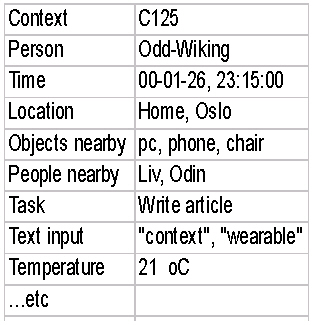
Position paper submitted to the CHI 2000 workshops
WS09: 'Research Directions in Situated Computing'
WS11: 'The What, Who, Where, When, Why and How of Context-Awareness'
WS14: 'Situated Interaction in Ubiquitous Computing'
April 2, 2000, The Hague, Netherlands
by Odd-Wiking Rahlff, Rolf Kenneth Rolfsen (SINTEF) and Jo Herstad (Univ. of Oslo / Ericsson)
Odd-Wiking.Rahlff@informatics.sintef.no, +47 2206 7426
Rolf.K.Rolfsen@informatics.sintef.no, +47 2206 7430
jo.herstad@oslo.online.no, +47 9156 0563
Distributed Information Systems
SINTEF Telecom and Informatics,
P.O. Box 124 Blindern, N-0314 Oslo
Norway
"I keep six honest
serving men
They taught me all I knew:
Their names are What and Why and When
And How and Where and Who"
[Rudyard Kipling, "Just So Stories", 1902]
Wearables are often described with a focus on providing the user with wearable information access and communication means. The contextual information retrieval aspect is however an essential feature of such systems, as in e.g. the Remembrance Agent [1] where manually entered search-terms are used for presenting relevant situational information, or as in different location-based systems [2]. In this position paper we outline a general framework of contextually aware wearable systems, and suggest how such mechanisms collecting massive traces of the user context may lead to several other interesting uses in what we will call consciousness technology.
Keywords: wearable computer, consciousness technology, context space, contextual awareness, context matching, information filtering
Miniaturisation of personal communication appliances makes it possible to construct wearable computers characterised by being (in principle) always on, being context sensitive, etc., as described in the wearable computer FAQ [3].
Mankind has actually already been using a "wearable computer" for millions of years: The brain. This highly effective 'oldest wearable' neural computer is always active and is always trying to present man with an understanding of his surroundings based upon his senses. It constantly tries to categorise the chaotic deluge of information bits presented to him by his senses in order to transform these into perceptions. Thus the brain's inherent pattern matching ability filters the burst of the outside world into a manageable dripping of consciousness experience that can be dealt with in real time.
Maybe there is a lesson to learn from this analogy.
An important aspect of human behaviour is that of the personal context. This can be defined briefly as snapshot of the state of the most important situational parameters: personal identification, time, location, task at hand, nearby objects, nearby people, etc. Below is a figure of an example record where these data could be gathered as seen from a person-centred point.

Figure 1: Example of person-centred context record
As can be seen, some of the fields are essential ("person", "time", "location"), while others are rather arbitrary (e.g. "temperature").
Some fields may be updated automatically, e.g. "time", "temperature", others can be set semi-automatically, like "location", while some will need manual input, e.g. "text input" (which actually could be the user's interaction stream with other devices). The more fields that can be derived automatically, the better; e.g. by filling in relevant text input by mechanisms like automatic speech recognition.
Also the context should be extensible, when a user for instance adds a biometric sensor and wants this context recorded as well.
Some of the fields of the context record may be derived by looking up other people's records, if they grant you access to these or parts of them. An example of this is "people nearby" that can be derived by checking out whether other people were present at the same place at the given time. The privacy problems and challenges that arise from such kind of mechanisms will not be addressed here.
In a given context, we intuitively see which other contexts may be within reach from that context. We may e.g. enter a meeting, and our perception of the hushed silence there immediately affords the context of our leaving or silently joining. This context matching ability is very essential and may be enhanced by personal information appliances.
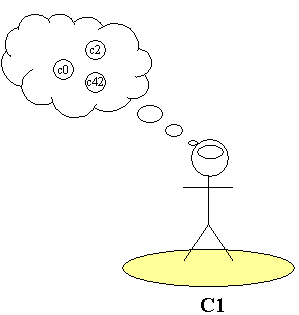
Figure 2: Using our brain for context matching
In figure 2 the user is situated in a context c1, which he associates with the actual or possible contexts c0, c2, and c42.
A long-term goal of the wearable community could be to create a companion system that somehow replicates this kind of process, using artificial sensors and contextual displays, so the user may experience an enhanced and, ideally, non-obtrusive perception of the world (figure 3). (The system may of course also empower the user with additional abilities as well, such as remote seeing and -talking, i.e. video telephony and telephone communication, etc.) The user of such technology would ideally perceive the system as being an extension of the awareness functionality of his own brain.
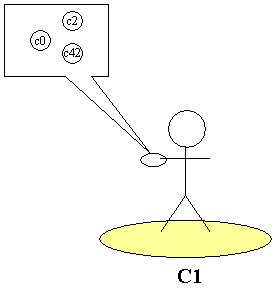
Figure 3: Using a wearable for context matching
In order to match the user's current context with other contexts, these contexts must be represented like trigger rules as described by P.J. Brown in in [4] or, as we suggest: have been recorded in a format suitable for matching. Our idea differs with trigger rules in that the system uses the context traces of several users simultaneously. We may think of this recording as a continuous logging of a trace in the multidimensional context space (figure 4). Each wearable should have a mechanism, a silent logger, that unobtrusively logs context records as pearls on a string, and stores them safely for later use [5]. Context logging is also identified as an important architecture requirement for context-aware systems by Dey et al in [6]. A context trace could be collected over years, comprising a total record of a lifetime of usage, and collected by many users simultaneously into a collective database. Such a database would be more useful the more users populate it using truly wearable equipment that is able to do the silent logging unobtrusively.
The context space is a generalisation of the time-geography ideas of Hägerstrand from 1970 [7], but now with a possible technological basis for implementing the data collection and with an awareness purpose. It also may be viewed as a very downscaled precursor of the visionary ideas in the Soul Catcher project from British Telecom [8].
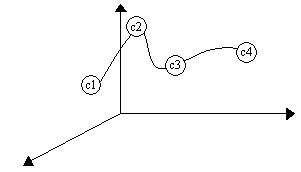
Figure 4: Context trace of four context records in (a 3-dimensional) Context Space
Ordering the logged context chronologically gives rise to a context timeline. If the silent logging is integrated with a time planner, the logging can be seen as the convergence point where possible future contexts (e.g. attending two simultaneous interesting events) are collapsing into the recorded past as the personal context trace is spun, as shown in figure 5.
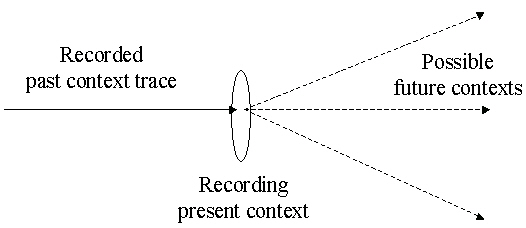
Figure 5: Possible future contexts "condensing" into the recorded past context trace
Note that we may now derive different context timelines, based upon the personal context timelines: A context timeline for a location; Louvre being populated by all the visitors there, etc. Another is a context timeline for a given group of people. Or one may wish to view context space through a view as a map, thereby projecting the context traces onto the location axis, showing the contexts spatially.
Your own context trace can be queried by personal requests like:
Such requests can be translated into queries, where e.g. for the first query the context field "Time" is left blank for the query to fill. By keeping some fields constant while releasing other fields, similar context records can be found.
The Remembrance Agent would be implemented as a context matching between current and logged "Text input".
If access to other people's traces is granted, the traces in context space could be used for the following types of queries:
Being able to answer such questions will enhance the user's context awareness [9]. We will refer to context-aware technology that uses matchings between massively recorded dynamic contextual traces, and notices the user of contexts nearby as consciousness technology. In a way consciousness technology constitutes a social and situational information filtering parallel to static search motors on the web, and may one day prove as useful in a social context provided the critical mass of users is reached.
It can be noted that classic location-based information systems belong to a subclass of such systems.
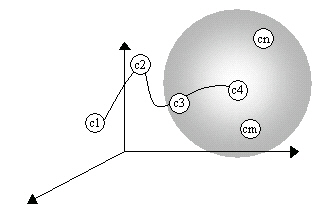
Figure 6: Sphere of contextual awareness (here with only 3 dimensions for illustration purposes)
The contexts that are closer to your own current context (c4 in figure 6) according to some clustering metric where each context field has some predefined "closeness-delta" are assumed to be most relevant for the user (cn and cm in figure 6). These can be the user's own earlier context, or the contexts of people being simultaneously at the same location. Also, it would probably be a good idea to give some context fields more importance/weight than other. For instance the context field "location" is certainly almost always more relevant than the context field "temperature".
Having the consciousness technology system present the closest context, may lead to serendipitous discovery, where e.g. you suddenly detect the contextual "presence" of somebody else working simultaneously on the same task as you, and going to the same meeting tomorrow.
Some of these queries, like those involving social navigation, are much more computation intensive, as they are based on statistical data from context traces.
Teleconversations are hampered by the lack of contextual knowledge of the communicating parties [10]. Therefore, the communication should preferably contain a pointer to the respective current context in order to improve the communication itself.
The concepts mentioned spins several research and design challenges like:
In SINTEF we now work on an internal mobile informatics project, LAMA, which will be addressing some of these issues through experimental demonstrators.
The concept of logging the context trace of the user of a wearable and using mechanisms of contextual awareness in this space seems like a fertile view of these systems that ultimately will augment us with consciousness technology. It is our hope that the suggested framework will contribute to more focused research in this interesting area.
B. Rhodes, MIT, Remembrance Agent: A continuously running automated information retrieval system
Rahlff, O.W, Rolfsen, R.K, Stegavik.
H., Where am I now, computer?,
presentation at Wearable computing
workshop, i3AC-98, i3 Annual Conference,
Nyborg, Denmark: June 1998.
Brown, P.J., Triggering information by context, Personal Technologies, 2(1):1-9, September 1998.
Rahlff, O.W, Rolfsen, R.K, Herstad,
J., The Role of Wearables in Social Navigation,
Chapter 12 in Social
Navigation of Information Space, p
217-236, Editors: Alan J. Munro, Kristina Höök, David
Benyon (August 1999),
CSCW-series, Springer-Verlag, UK;
ISBN: 1-85233-090-2.
Dey, A. K., Salber, D., Abowd, G. D.,
Futakawa, M., An
Architecture To Support Context-Aware Applications,
Submitted to the 12th Annual ACM
Symposium on User Interface Software and Technology (UIST
'99), June 1999.
Parkes, D. N. , Thrift N. J., Times, Spaces and Places: A Chronographic Perspective, Chapter 6: Time-geography: The Lund approach, p 243, ff. (Wiley & Sons: UK), 1980.
The Soul Catcher, British Telecom
Rolfsen, R. K,. , Jørgensen, H. D., and Carlsen, S., Contextual Awareness: Survey and Proposed Research Agenda, SINTEF Telecom and Informatics, 1999.
Rahlff, O. W., Rolfsen, R. K.,
Herstad, J., Thanh, D. v., Context and Expectations
in Teleconversations,
Proceedings of HCI International '99
(the 8th International Conference on Human-Computer
Interaction),
Munich, Germany, August 22-27, 1999,
vol 2, p 523-527, ISBN 0-8058-3392-7.
Last updated on February 10th, 2000, by Odd-Wiking Rahlff.